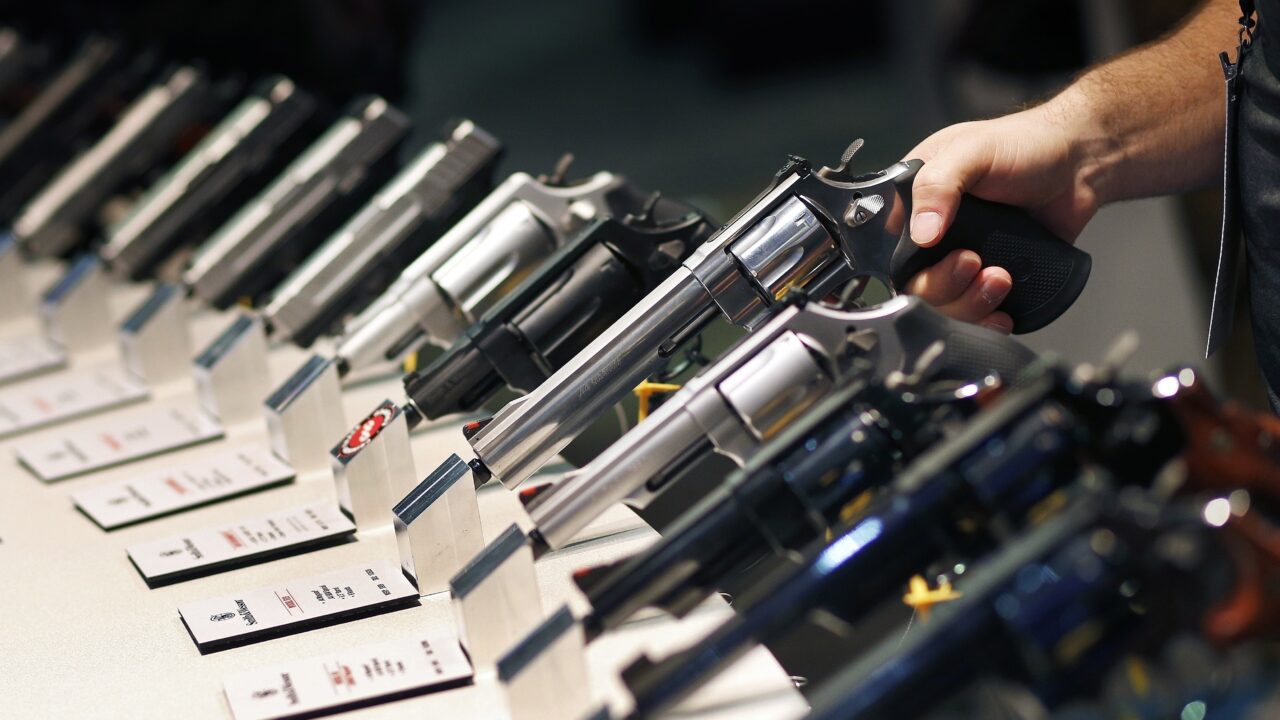Abusers and the Right to Bear Arms
A new domestic violence case will test the Supreme Court’s Second Amendment fundamentalism. In this Jan. 19, 2016, file photo, handguns are displayed at the Smith & Wesson booth at the Shooting, Hunting and Outdoor Trade Show in Las Vegas. (AP Photo/John Locher, File)
In this Jan. 19, 2016, file photo, handguns are displayed at the Smith & Wesson booth at the Shooting, Hunting and Outdoor Trade Show in Las Vegas. (AP Photo/John Locher, File)
Should individuals subject to domestic violence restraining orders be allowed to own guns? If you think the answer is a screaming, obvious “No,” you haven’t been paying much attention to the Supreme Court’s radical reinterpretations of the Second Amendment over the past 15 years. The court will be asked to decide the issue in United States v. Rahimi when it reconvenes in October.
At the center of the case is Zackey Rahimi, a 23-year-old with a history of violence and drug dealing. In December 2019, Rahimi beat up his girlfriend in a parking lot in Arlington, Texas, and tried to shoot a bystander who had witnessed the attack. Two months later, his girlfriend obtained a restraining order from a state court judge that prohibited him from harassing her, and barred him from possessing a firearm.
It didn’t take Rahimi long to resume his menacing ways. In August 2020, he was arrested for stalking his ex; in November, he threatened another woman with a gun. In December 2020 and January 2021, he participated in a series of five shootings in the Arlington area. Police in Arlington identified him as a suspect in the shootings and obtained a warrant to search his home, where they uncovered a .45- caliber pistol, a .308-caliber rifle, pistol and rifle magazines, additional rounds of ammunition, approximately $20,000 in cash and a copy of the restraining order Rahimi had flagrantly violated.
At the center of the case is Zackey Rahimi, a 23-year-old with a history of violence and drug dealing.
The police alerted an agent with the Federal Bureau of Alcohol, Tobacco, Firearms and Explosives about what they had found, and a federal grand jury subsequently indicted Rahimi for violating section 922(g)(8) of the Gun Control Act of 1968, which prohibits anyone subject to a domestic violence protective order from possessing a firearm. The section was added to the Gun Control Act with bipartisan support in 1994, the same year Congress passed the Violence Against Women Act, which increased funding for the investigation and prosecution of violent crimes against women.
Represented by the Federal Public Defender’s Office for the Northern District of Texas, Rahimi moved to dismiss the indictment, arguing that section 922(g)(8) ran afoul of the Second Amendment. The trial court denied the motion, and Rahimi pleaded guilty. He was sentenced to serve six years in prison, but reserved his right to appeal the denial of his dismissal motion.
In 2022, Rahimi’s appeal came before the 5th Circuit Court of Appeals. Based in New Orleans, the circuit oversees federal litigation in cases from Mississippi, Louisiana, and Texas, and is widely regarded as the most conservative appellate panel in the country. In an article published this past January, Esquire magazine described the circuit as “the blown fuse of American jurisprudence” for its history of right-wing activism, particularly on abortion.
Despite its well-earned reputation as the go-to tribunal for the radical right, the circuit initially affirmed Rahimi’s conviction in a brief opinion issued on June 8, 2022. One month later, however, the circuit withdrew its opinion, and on March 3rd of this year, issued an amended decision, reversing Rahimi’s conviction and declaring section 922(g)(8) unconstitutional.
As its amended opinion makes abundantly clear, the circuit’s about-face was prompted by the Supreme Court’s decision in New York Rifle & Pistol Association v. Bruen. Decided on June 23, 2002, Bruen struck down a century-old New York state regulation on concealed handgun permits on Second Amendment grounds.
In both Bruen and Dobbs v. Jackson Women’s Health Organization, in which the Supreme Court overturned Roe v. Wade the day after it decided Bruen, the court abandoned the methods of judicial scrutiny that judges have long used to determine the constitutionality of challenged laws by balancing the governmental interests advanced by the laws in question against the competing rights of individuals affected by the laws. In place of such interest-balancing, the Supreme Court substituted an “originalist” test based exclusively on the Justices’ highly selective reading of history and their sense of tradition.
Applying Bruen’s history and tradition standard to domestic violence, the 5th Circuit held that while section 922(g)(8) “embodies salutary policy goals meant to protect vulnerable people in our society”…it is “an [historical] outlier that our ancestors would never have accepted.”
The sexism of the 5th Circuit’s reasoning is blatant. By “our ancestors,” the circuit had in mind the views and interests of the wealthy white men who drafted and debated the merits of the Constitution during the “founding era” at the close of the 18th century. Excluded from the court’s opinion is any mention of the views or interests of the women of that era, who not only lacked the right to vote, but also had no legal protections against domestic violence.
The Justice Department moved quickly to petition the Supreme Court to review the 5th Circuit’s decision, and on June 30, the last day of its 2022-23 term, the court agreed to hear the case.
By “our ancestors,” the circuit had in mind the views and interests of the wealthy white men who drafted and debated the merits of the Constitution during the “founding era” at the close of the 18th century.
The Supreme Court is now poised to expand the reach of the Second Amendment yet again, continuing a process that began in 2008, when it sold its soul to the gun lobby with its 5-4 majority opinion written by the late Antonin Scalia in District of Columbia v. Heller, that held for the first time that the Second Amendment protects an individual right to own firearms.
Prior to Heller, the great weight of academic scholarship as well as the court’s 1939 decision in United States v. Miller had construed the Second Amendment, in keeping with the actual debates of the Constitutional Convention, as protecting gun ownership only in connection with service in long-since antiquated state militias.
In 2010, the court again genuflected to the gun lobby. In another 5-4 opinion in McDonald v. Chicago, this time written by Samuel Alito, the court extended Heller, holding that the individual right to keep and bear arms is “incorporated” by the 14th Amendment’s due process clause and is therefore applicable to the states and local governments.
Last year’s Bruen decision was decided on a 6-3 vote, with all the court’s Republican appointees, including Chief Justice John Roberts, joining Clarence Thomas’ majority opinion.
Still, there is some cause for optimism. Rahimi is an especially ugly standard-bearer for gun-rights groups. “In some ways Rahimi…is the best case for gun safety advocates,” UCLA law professor Adam Winkler told USA Today in a recent interview. “The Justices are going to be understandably reluctant to say that domestic abusers have a right under the Second Amendment to possess firearms.”
To-date, no gun-rights groups have filed amicus (“friend of the court”) briefs on Rahimi’s behalf with the Supreme Court, although representatives from both the Second Amendment Foundation and Gun Owners of America told USA Today that they planned to do so.
In the meantime, the court remains mired in a crisis of legitimacy that has seen its public approval ratings plummet to all-time lows. A ruling in Rahimi’s favor will likely aggravate that crisis, and for good reason. Every month an average of 70 women are killed by an intimate partner — some of whom had protection orders against their killers.
The court has until the end of June to resolve the case, just before the 2024 elections.
Your support matters…Independent journalism is under threat and overshadowed by heavily funded mainstream media.
You can help level the playing field. Become a member.
Your tax-deductible contribution keeps us digging beneath the headlines to give you thought-provoking, investigative reporting and analysis that unearths what's really happening- without compromise.
Give today to support our courageous, independent journalists.






You need to be a supporter to comment.
There are currently no responses to this article.
Be the first to respond.